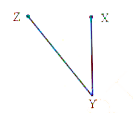The bisector of an angle is produced backwards .It bisects which angle at the same vertex ?
acute
obtuse
reflex
complete
The correct Answer is:C
To solve the problem step by step, we need to understand the concept of angle bisectors and how they relate to the angles they bisect.
1. Understanding the Angle Bisector:
- An angle bisector is a line that divides an angle into two equal parts. For example, if we have an angle of 90 degrees, the bisector will create two angles of 45 degrees each.
2. Assuming an Angle:
- Let’s assume we have an angle ∠AOB which measures 90 degrees. The bisector of this angle will divide it into two equal angles of 45 degrees each.
3. Drawing the Bisector:
- Draw the angle ∠AOB and then draw the bisector line OC from point O such that it divides ∠AOB into two equal angles (45 degrees each).
4. Producing the Bisector Backwards:
- Now, if we extend the bisector line OC backwards, we denote the new point as A'. This means we are considering the angle A'OA.
5. Finding the Measure of Angle A'OA:
- Since AOB is 90 degrees, the straight line A'OA will measure 180 degrees. Therefore, we can say:
Angle A'OA=Angle AOB+Angle BOC
180∘=45∘+x
- Here, x is the angle we need to find, which is the angle A'OA.
6. Calculating the Value of x:
- Rearranging the equation gives:
x=180∘−45∘=135∘
7. Identifying the Type of Angle:
- Now we have found that the angle A'OA measures 135 degrees. This angle is classified as an obtuse angle since it is greater than 90 degrees but less than 180 degrees.
8. Finding the Angle Bisected by the Extended Bisector:
- The angle AOC (which is the angle formed by the bisector) is 135 degrees. The total angle formed by the extended bisector A'OA is:
135∘+135∘=270∘
- Since this angle is greater than 180 degrees, it is classified as a reflex angle.
9. Conclusion:
- Therefore, the bisector of the angle AOB, when produced backwards, bisects a reflex angle of 270 degrees.
Final Answer:
The bisector of an angle produced backwards bisects a reflex angle.
- An angle bisector is a line that divides an angle into two equal parts. For example, if we have an angle of 90 degrees, the bisector will create two angles of 45 degrees each.
- Let’s assume we have an angle ∠AOB which measures 90 degrees. The bisector of this angle will divide it into two equal angles of 45 degrees each.
- Draw the angle ∠AOB and then draw the bisector line OC from point O such that it divides ∠AOB into two equal angles (45 degrees each).
- Now, if we extend the bisector line OC backwards, we denote the new point as A'. This means we are considering the angle A'OA.
- Since AOB is 90 degrees, the straight line A'OA will measure 180 degrees. Therefore, we can say:
Angle A'OA=Angle AOB+Angle BOC
180∘=45∘+x
- Here, x is the angle we need to find, which is the angle A'OA.
- Rearranging the equation gives:
x=180∘−45∘=135∘
- Now we have found that the angle A'OA measures 135 degrees. This angle is classified as an obtuse angle since it is greater than 90 degrees but less than 180 degrees.
- The angle AOC (which is the angle formed by the bisector) is 135 degrees. The total angle formed by the extended bisector A'OA is:
135∘+135∘=270∘
- Since this angle is greater than 180 degrees, it is classified as a reflex angle.
- Therefore, the bisector of the angle AOB, when produced backwards, bisects a reflex angle of 270 degrees.
The bisector of an angle produced backwards bisects a reflex angle.
Topper's Solved these Questions
- BOOK - S CHAND IIT JEE FOUNDATIONCHAPTER - LINES AND ANGLES EXERCISE - QUESTIONS BANK22videos
LINES AND ANGLES
- BOOK - S CHAND IIT JEE FOUNDATIONCHAPTER - LINEAR EQUATIONS IN ONE VARIABLEEXERCISE - Unit Test -220videos
LINEAR EQUATIONS IN ONE VARIABLE
- BOOK - S CHAND IIT JEE FOUNDATIONCHAPTER - NUMBERSEXERCISE - SELF ASSESSMENT SHEET-110videos
NUMBERS
Similar Questions
Knowledge Check
- Question 1 - Select One
The bisector of the angles of a parallelogram enclose a
ArectangleBrhombusCsquareDtrapezium - Question 2 - Select One
The side BC of ΔABC is produced to D. The bisectors of ∠ABCand∠ABD meet at E. If AB = AC and ∠BEC=24∘. then the measure of ∠ABC is :
AA)60∘BB)72∘CC)48∘DD)66∘
Show that the bisector of vertical angle of an isosceles triangle bisects the base at right angles.
View SolutionIf the given lines be 3x+4y−11=0 and 12x−5y−2=0, then find the bisectors of the angles between them and discriminate which bisects the acute angle or which bisects the obtuse angle .
View SolutionIf the bisector of an angle of a triangle bisects the opposite side, prove that the triangle is isosceles.
View SolutionBisect ∠XYZ
 View Solution
View SolutionAngle bisectors| problems
View SolutionTo construct the bisector of a given angle.
View Solution

